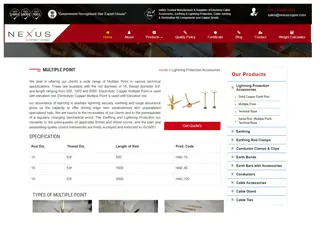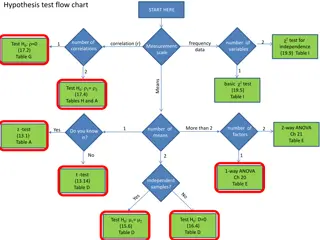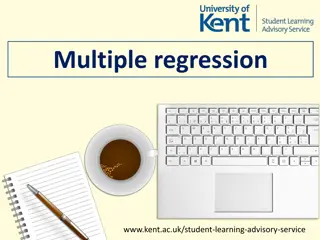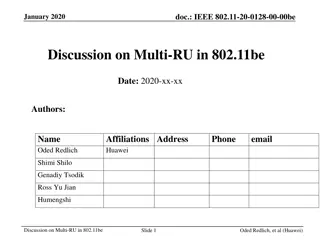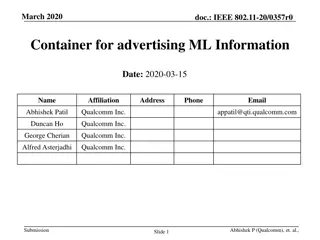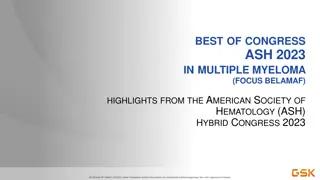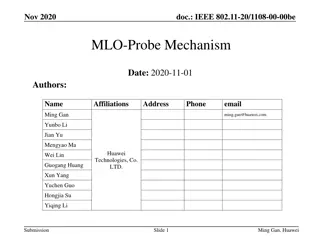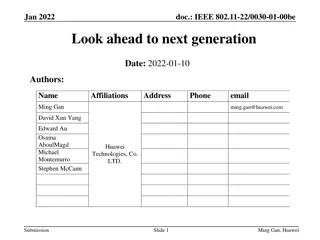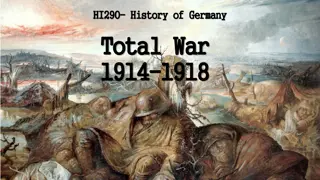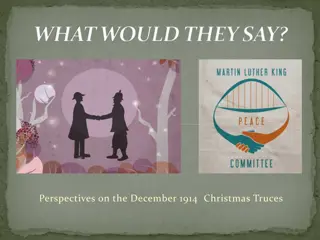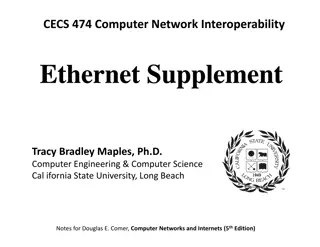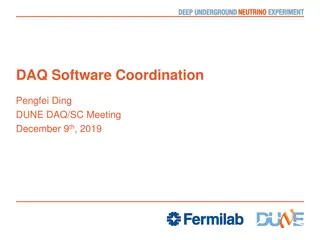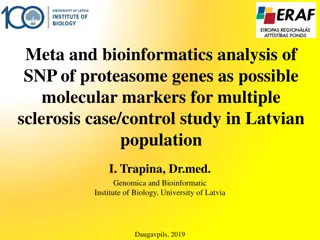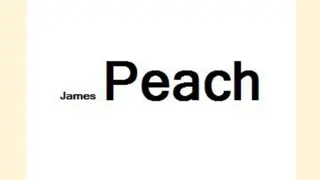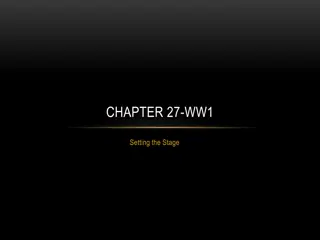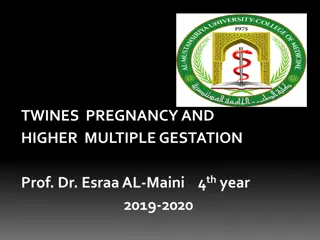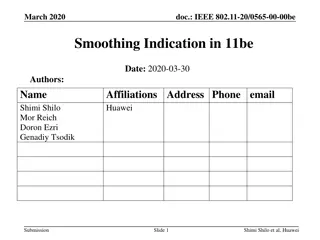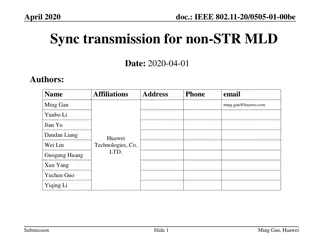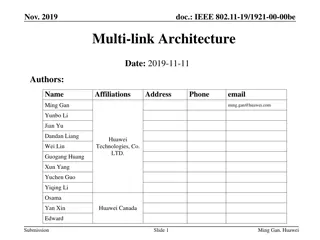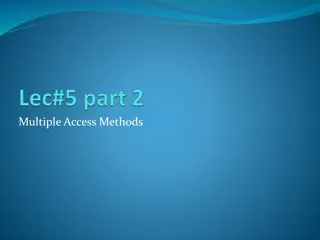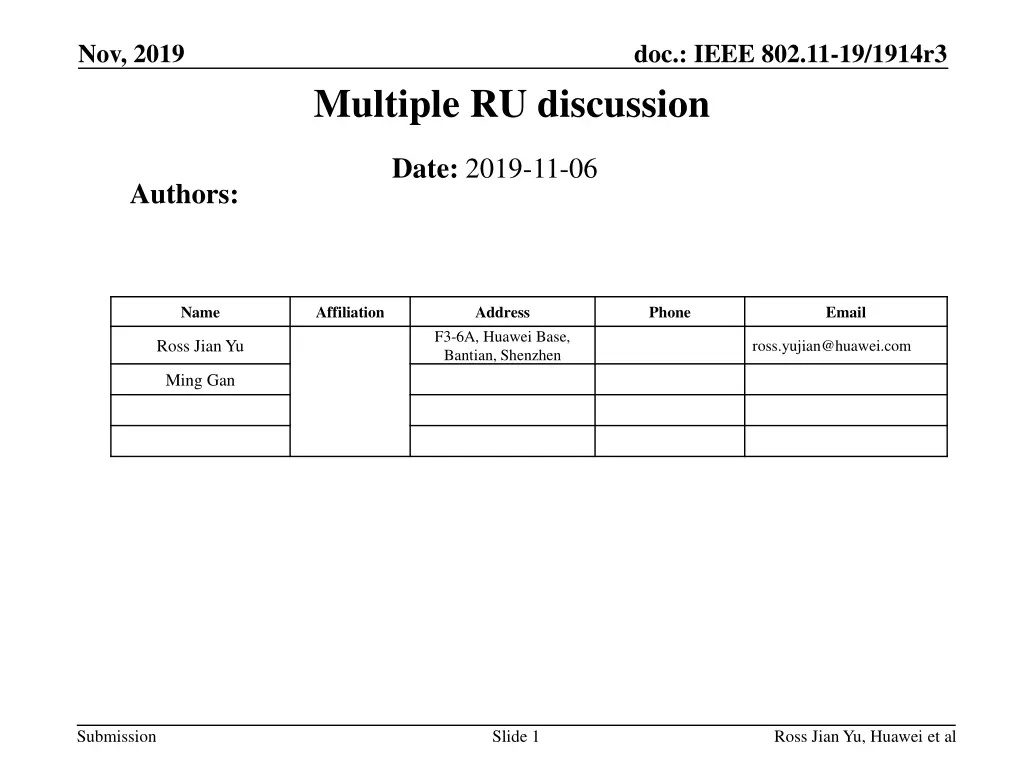
IEEE 802.11-19/1914r3: Enhancing Spectral Efficiency with Multiple RUs
Explore the proposal to support multiple RUs for one user transmission in IEEE 802.11-19/1914r3, focusing on PPDU formats, signaling, and transmission methods. Discusses the implications on spectral efficiency and potential optimizations. Simulations on different transmission methods are also highlighted.
Download Presentation

Please find below an Image/Link to download the presentation.
The content on the website is provided AS IS for your information and personal use only. It may not be sold, licensed, or shared on other websites without obtaining consent from the author. If you encounter any issues during the download, it is possible that the publisher has removed the file from their server.
You are allowed to download the files provided on this website for personal or commercial use, subject to the condition that they are used lawfully. All files are the property of their respective owners.
The content on the website is provided AS IS for your information and personal use only. It may not be sold, licensed, or shared on other websites without obtaining consent from the author.
E N D
Presentation Transcript
Nov, 2019 doc.: IEEE 802.11-19/1914r3 Multiple RU discussion Date: 2019-11-06 Authors: Name Affiliation Address Phone Email F3-6A, Huawei Base, Bantian, Shenzhen Ross Jian Yu ross.yujian@huawei.com Ming Gan Submission Slide 1 Ross Jian Yu, Huawei et al
Nov, 2019 doc.: IEEE 802.11-19/1914r3 Background In [1], it is mentioned, multiple RUs for one user should be supported to enhance spectral efficiency, take advantage of frequency diversity. This proposal discusses several aspects regarding multiple RUs for one user transmission: PPDU format Transmission in Data field Signaling Submission Slide 2 Ross Jian Yu, Huawei et al
Nov, 2019 doc.: IEEE 802.11-19/1914r3 Multiple RUs for one user - PPDU format For EHT MU PPDU and EHT TB PPDU, since OFDMA is already supported, it is straightforward to support multiple RUs for one user. How many RUs can one STA support needs to be further evaluated, depending on the complexity and cost For EHT SU PPDU, if 11be supports preamble puncture for SU PPDU. Because of puncture, there will be several discontiguous channels. If the discontiguous channels are seen as different RUs, and since SU is targeted for one user, then multiple RUs for one user should also be supported. Submission Slide 3 Ross Jian Yu, Huawei et al
Nov, 2019 doc.: IEEE 802.11-19/1914r3 Multiple RUs for one user Transmission in Data Field There can be several ways to transmit the data in multiple RUs: Method Pro Con Opt1 act as transmit the data to two different users, each RU is encoded, interleaved separately Opt2 The bits are encoded together, and parse to different RUs, separate interleaver/tone mapper Opt3 Opt1/Opt2+interleaver across RUs Can reuse existing Tx procedure. Full flexibility regarding MCS, NSS. Similar procedure as 160/80+80MHz transmission Robustness is not fully achieved Require parallel MAC processing Robustness is not fully achieved May need to define new encoding parameters Need interleaver across RUs Pro of Opt1/Opt2 Fully utilize the robustness Can reuse existing Tx procedure if big RU is already defined RU Opt4 Act as one big continuous RU Need new parameters for encoding, interleaver if big RU is not defined Submission Slide 4 Ross Jian Yu, Huawei et al
Nov, 2019 doc.: IEEE 802.11-19/1914r3 Multiple RUs for one user - Signaling Regarding signaling, for EHT MU PPDU and EHT TB PPDU, the simplest way is to enable the same AID for multiple user fields. May affect the procedure of parsing. Previously, the STA can stop decoding once its own AID is detected. May need some signaling to tell the STAs when to stop parsing. With some restriction, for example, same MCS, NSTS, some further optimization regarding overhead can be considered. Submission Slide 5 Ross Jian Yu, Huawei et al
Nov, 2019 doc.: IEEE 802.11-19/1914r3 Simulations We ran simulations on Opt 2 and Opt 4. The simulation settings are as follows: ChD MPDU length: 1600 bits Single BCC encoder, 4Tx, 3Rx, 3SS or 1Rx, 1 SS, MCS5 Opt2: bits are parsed into one 26-tone RU and one 52-tone RU, reuse existing interleaver for each RU separately Opt4: one interleaver for 78-tone RU (new defined interleaver) No CFO, no PN, perf CHEST Submission Slide 6 Ross Jian Yu, Huawei et al
Nov, 2019 doc.: IEEE 802.11-19/1914r3 Simulations Opt2:Separate interleaver Opt4: single interleaver Submission Slide 7 Ross Jian Yu, Huawei et al
Nov, 2019 doc.: IEEE 802.11-19/1914r3 Wrap up Several aspects regarding multiple RUs for one user transmission have been discussed regarding: PPDU format Transmission in Data field Signaling Regarding transmission in the data field: Opt2 and Opt4 show similar performances. A tradeoff between reusing existing interleaver and single interleaver per combined RU can be further considered. Opt3 will be further studied and evaluated. Opt1 is not preferred regarding complexity Submission Slide 8 Ross Jian Yu, Huawei et al
Nov, 2019 doc.: IEEE 802.11-19/1914r3 Straw Poll 1 Do you support that for LDPC coding, for combined RUs sent to a user with RU size less than 242-tone, a joint tone mapper shall be considered? Submission Slide 9 Ross Jian Yu, Huawei et al
Nov, 2019 doc.: IEEE 802.11-19/1914r3 Reference 1. https://mentor.ieee.org/802.11/dcn/19/11-19-1126-00-00be- enhanced-resource-unit-allocation-schemes-for-11be.pptx Submission Slide 10 Ross Jian Yu, Huawei et al

